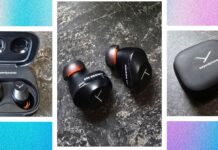Fortunately, this system is idiot-proof — and not just when it comes to sudden, spontaneous drop tests. You plug it in, you do what the app says, and 10 minutes later your new mesh network is up and running and spreading a Wi-Fi signal throughout your house that’s about as speedy as you could reasonably expect. It’s as easy as setting up a smart speaker, because in addition to extending the Nest Wifi Router’s range, each Nest Wifi Point is, itself, a smart speaker. You get one of each — the Google Nest Wifi Router and a Nest Wifi Point with built-in microphones and surprisingly adequate bass — for $269 (£239, AU$399).
The Nest Wifi Router, left, and a range-extending Nest Wifi Point. The holes on the top of the Point are for the far-field microphones it uses to listen for your Google Assistant voice commands.
Between the presence of Google Assistant and the fact that you’ll run everything through the Google Home app, the Nest Wifi asks you to plant a foot in Google’s smart-home garden if you haven’t done so already. And it isn’t cheap. For comparison, the third-gen, three-piece mesh system from Amazon-owned Eero costs $249, or 20 bucks less than a Nest Wifi setup with just two devices. Meanwhile, a three-piece Netgear Orbi AC1200 mesh system costs $229 at Best Buy. That’s more than $100 less than the three-piece version of Nest Wifi.
Still, the Nest Wifi proved fast, reliable and easy to use, and it edged out the Eero and Orbi in my speed tests (yes, even after I dropped it). It doesn’t support the latest, fastest version of Wi-Fi, called Wi-Fi 6, but that only really matters if you expect to have an internet connection that’s faster than 500 megabits per second or so within the next few years (don’t hold your breath).
That all adds up to the mesh router I would tell most people to consider first if they were thinking about buying one right now. The winner of our Editors’ Choice Award, the Google Nest Wifi, is a great upgrade for anyone who’s already invested in Google’s internet ecosystem of services and devices, particularly those who would welcome the chance to expand Google Assistant’s footprint in their home. But those who aren’t committed to Google at this point would be wise to shop around, because better mesh values with comparable coverage are already available today.
The Nest Wifi Router only comes in white, but the Nest Wifi Points come in your choice of three colors.
Editors’ note, April 8, 2020: We have updated this review with testing data from additional products. Google Nest Wifi remains one of our top mesh router picks.
A new design
Google is currently working to center all of its smart home offerings behind a unified Nest brand. Hence, what was Google Wifi is now Google Nest Wifi. Google marked the occasion with a brand new design, faster top speeds, and the addition of Google Assistant voice controls in each each Nest Wifi Point. And, in a welcome touch for existing users, all of the new hardware is backwards-compatible with the previous-gen Google Wifi gear.
Read more: Nest Wifi vs. Google Wifi: All the ways the two mesh routers are different
Nest branding aside, you’ll control everything via the Google Home app, which requires you to have a Google account. The app is clean and fairly simple, and it does a great job of walking you through a setup process that’s easy to begin with. You just plug everything in, tell the app to connect with the router, and then scan a QR code on the bottom of each Point with your phone’s camera. A few minutes later, your mesh network will be up and running.
The Google Home app lets you create groups of devices on your network and then pause their internet access whenever you like. Be afraid, unruly children.
The app doesn’t offer quite as many features as something like a dedicated gaming router, but you still get some useful controls over your network. You can view the devices connected to it and group them together, then pause the connection to those devices at any time you like, including with a quick voice command. That’s basically a parental superpower, but it’s not exclusive to Google — most decent routers some form of device-blocking functionality at this point, and several can sync up with Alexa or the Google Assistant to let you turn the connection on and off for groups of devices using a quick voice command.
The Nest Wifi can also prioritize traffic to any of the devices on your network, which comes in handy if you’re streaming 4K video or gaming online. Speaking of gaming, the system will automatically prioritize traffic for Google Stadia, the search giant’s cloud gaming platform.
You only get one spare gigabit Ethernet port on the bottom of Nest’s router — and the Nest Wifi Point doesn’t include any Ethernet jacks at all.
As for the hardware itself, the Nest Wifi Router and Nest Wifi Point each feature a simplistic, inoffensive design that’s built to blend into your home without needing to be hidden out of sight, where they won’t perform as well. To that end, the Points come in your choice of three colors, but the Router only comes in white.
One other quibble: The router only includes a single spare Ethernet jack, and there aren’t any Ethernet jacks on the Points at all. That means you only get a single wired connection for something like a gaming console or a smart home bridge before you’ll need to buy a separate Ethernet hub. It also means you can’t run a cable to the Nest Wifi Point to daisy-chain a wired connection for faster mesh performance.
You can tap the top of the Nest Wifi Point to pause or resume playback, or to adjust the volume. Like with the Nest Mini, indicator lights will show you where those volume controls are located.
Speaking of the Points, they’re functionally identical to Google’s Nest Mini smart speakers. They include access to all of the same, voice-activated Google Assistant features, as well as a microphone mute switch in the back and touch controls on top. Sound quality is more or less on par with the Nest Mini and with other small smart speakers such as the Amazon Echo Dot — which is to say that it’s ideal for casual listening, but likely to underwhelm at a house party.
Like the Google Wifi before (and like most other mesh networks), the dual-band Nest Wifi doesn’t separate the 2.4GHz band from the faster 5GHz band. Instead, it automatically “steers” you between the two of them on a single network as you move throughout your home. This worked particularly well in my tests, where I moved from room to room, running speed test after speed test — I never noticed any hiccups in the signal whatsoever. Despite dropping the thing, it never once saw fit to return the favor and drop my connection.
The mesh category is getting crowded — and increasingly affordable.
Is Nest’s mesh best?
At launch in 2019, the Nest Wifi’s top two competitors were the Eero and Netgear Orbi, two high-profile rivals who each launched new mesh systems around the same time as Google, each of them is less expensive than Nest. With the Eero, you get a three-piece mesh setup for $249. With the newest Netgear Orbi system, a three-piece setup costs $229. For comparison, a three-piece Nest Wifi setup costs $349.
Since then, we’ve seen a number of new mesh systems hit the market, including several new systems that support next-gen Wi-Fi 6 speeds. They include a faster, fancier Netgear Orbi system and a more budget-friendly Netgear Nighthawk setup, as well as a new Wi-Fi 6 Asus ZenWiFi mesh system.
So, how does the Nest Wifi measure up?
Top speeds
When testing a single device from each system, the Netgear Orbi was the fastest at close range, but the Nest Wifi router performed better at a distance, which gave it the best overall average in this top speed test. Meanwhile, a single Eero’s top speeds plummeted at distances greater than 30 feet.
We started by taking a look at each system’s top transfer speeds. For this test, we wire each system’s router to a MacBook Pro that we use as a local server. Then, we use a second laptop connected to the router’s wireless network to download data from the MacBook. That shows us how fast each router can transfer data without any of the extra variables that you get when you’re pulling data from the cloud. And, by running our speed tests at multiple distances, we get a look at each router’s range, too.
Nest did well in this test — and better than any other Wi-Fi 5 mesh router we’ve tested to date. With top measured speeds of 612Mbps, the standalone Nest Wifi Router wasn’t quite as fast at the Netgear Orbi AC1200 router was at close range, but it was noticeably faster in the medium- and long-range tests. That gave it a faster overall average across all three distances that we tested.
Meanwhile, a single Eero was able to transfer data at just under 500Mbps at close range. That’s a solid number for a single mesh device, but speeds fell off considerably at medium and long range.
It’s an interesting disparity, especially given that Nest and Netgear each feature designated routers that are distinct from the range extenders. Eero, on the other hand, offers three identical devices, any one of which can serve as the system’s router. Don’t be too quick to write Eero off, though. At long ranges like that, these multipoint systems expect to be routing your traffic through a second device. That meant we had more testing to do.
And then there are the systems to the left of Nest Wifi in that chart. Each of them supports Wi-Fi 6, which explains the higher top transfer speeds. Most of them also cost $200-$400 more than Nest Wifi costs, although the Netgear Nighthawk system actually costs less than Nest Wifi.
But again, we’ve got more tests to look at.
Real-world speeds
Specifically, I wanted to get a good sense of how these mesh routers performed when used as intended in an actual home setting. So, I took each system home, set them each up on my network, and then ran lots and lots of speed tests in five different spots around my house. By the end, I ran 120 speed tests for each system — two separate sets of 15 tests each in the morning, daytime and evening hours to give me the most accurate averages possible for each system, plus two more sets of 15 speed tests with just the router working on its own.
Again, Nest did well, but in this real-world environment, it was much closer. My home, a skinny, little shotgun-style house in Louisville, Kentucky, is only about 1,300 total square feet, but it still has its dead zones — particularly, a back bathroom located at the very rear of the house. On their own, none of the system’s routers were able to muster speeds much faster than 50Mbps or so back there, and my home has a 300Mbps fiber internet connection.
These are the average download speeds by room for Nest, Eero, and the AC1200 version of Netgear Orbi after running 90 speed tests with each system in a home with a 300Mbps internet connection. Again, Nest averaged the highest overall speeds, especially at a distance, but the three were very close.
Then, I added a single range extender in an adjacent bedroom — with Nest, one of the Nest Wifi Points. With the mesh kicked in, each system’s speeds were much faster at range, including average speeds of well over 100Mbps in that back bathroom from all three. The Nest averaged the fastest download speeds throughout the house, with an impressive overall average of 222Mbps. The Eero was the runner-up with a whole-home average of 204Mbps, and the budget-priced Netgear Orbi finished a respectable third, averaging 195Mbps.
Close as it was, Nest’s network seemed a little more robust than the others, with an average upload speed of 229Mbps throughout the home compared to 166Mbps and 169Mbps for Eero and Netgear, respectively. As for latency spikes, I only counted six across all 120 of the Nest tests — but the others did even better. Netgear’s ping to a server located on the other end of Kentucky was only noticeably higher than average during 5 tests out of 120. Eero’s ping only spiked twice.
Among systems that support Wi-Fi 6, the AX6000 version of Netgear Orbi and the Asus ZenWifi AX sit at the top of the leaderboard in my real-world tests, but each costs hundreds more than Nest Wifi.
That brings us to Wi-Fi 6, and as you might have guessed, average speeds were pretty much higher across the board. The one exception was the Netgear Nighthawk system, which finished with an average download speed of 219Mbps, slightly slower than Nest. This was largely due to the fact that poor mesh performance and band-steering compromised the quality of my connection with that system as I moved throughout my house. That’s why the Nighthawk isn’t a mesh system that I’d recommend, even if the $230 price tag seems pretty tempting.
As for the rest, our fastest mesh system of all is the AX6000 version of Netgear Orbi, which rang in with an eye-popping average of 289Mbps throughout my entire home. Currently available for $600 at Best Buy (a sale price!), it’s an extremely expensive option, and really only worth it for advanced users ready to take full advantage of its capabilities. Not sure if that’s you? I’ve got a full breakdown of Nest Wifi vs. Netgear Orbi 6 that you might find helpful.
Next fastest overall at 272Mbps was the Asus ZenWiFi AX, a two-piece Wi-Fi 6 mesh system that costs $450. It’s an extremely well-rounded system that just about aced my tests, and it’s the only router aside from the Nest Wifi that I’ve ever awarded Editors’ Choice. Nest Wifi is the better overall value between the two, and easily strong enough for most homes, but if you’re itching for an upgrade (or if Wi-Fi 6 is a must at this point), then the ZenWiFi AX belongs right at the top of your list.
The verdict
A mesh router system makes for a smart, sensible upgrade to your home’s network, particularly if you’re struggling with dead spots. The Google Nest Wifi is an excellent option, but at $269 for a two-piece system or $349 for a three-piece system, it isn’t as good a value as Eero or the AC1200 version of Netgear Orbi, each of which offers a three-piece system for at least $100 less than Nest. The Nest system is also more expensive to expand, since the Wifi Points cost $149 each. Each Eero device costs $99 (Netgear isn’t selling standalone AC1200 Orbi satellites yet).
Nest’s lack of Wi-Fi 6 support might give you legitimate pause if you want something future-proofed, especially given that Wi-Fi 6 will only grow more and more relevant as more devices continue to adopt it. If you’ve reached the point where you’re using more than one Wi-Fi 6 device on your network, then a Wi-Fi 6 router like the Asus ZenWiFi AX probably makes more sense.
All of that said, the Google Nest Wifi is a terrific mesh router system in its own right, and a perfect platform for the connected lives of folks who already make regular use of Google’s products and services. The software that allows it to steer your connection from band to band and node to node as you move about your house is about as good as it gets — an essential strength for a mesh router. Like a good rug, it really ties everything together. Just please, try not to drop it.








